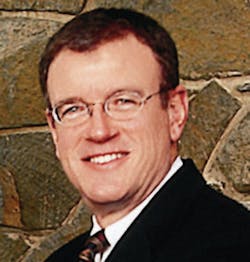Editor’s Note: As part of Locksmith Ledger’s 65th anniversary celebration, Ledger editors have had the opportunity to interview a number of icons of the industry. Many of these interviews appeared in our special supplement, “Pioneers of the Locksmith Industry,” in November. Editor Gale Johnson recently questioned Harry Stratton about his many accomplishments. Following is their conversation.
Just for the record, what is the full name people recognize you by?
HAROLD M. STRATTON II.
Your company has been in existence for a long time. Can you give us a brief history?
My grandfather, Harold Stratton and Mr. Stephen Briggs formed a partnership in 1908. Their first project was to build gasoline engines. The following year the company developed an automobile called the Superior. Both projects were not very profitable but they recognized the possibility of manufacturing component parts for the expanding automotive market and by 1915 Briggs & Stratton began making their first key-operated ignition switches.
Is the Briggs family still connected with the company?
No. Stephen Briggs later went on to form the Outboard Marine Corporation (OMC) and devoted his full attention there after 1948.
What are your earliest recollections of the company?
I can remember coming to the offices as a small boy and noticing that most of the furniture was a rather odd green color. That was because most of our office equipment at the time was war surplus. Briggs & Stratton was still making engines, locks and keys in the same plant back then.
Can you tell us about some of the inventions and innovations that your company has introduced or been involved with?
One of the earliest innovations was the use of die-casting for lock parts. The first locks used in cars were made of brass. Complicated lock shapes were time-consuming to make. Briggs & Stratton received the backing of Nash Car Company of Kenosha, Wis., and in 1923 began making die-cast lock parts. This allowed us to quickly make a variety of shapes and sizes of locks to meet increased demand.
Another important invention was the sidebar lock. It was introduced in the mid 1930s on GM cars. A later development was the spring-loaded unit shutter for auto locks.
Our company worked with GM and the Allen-Bradley Company on the introduction of VATS vehicle anti-theft systems first used in the 1986 Corvette. The PASSkey system was developed in the 1990s.
When did you begin your career with the company?
I joined Briggs & Stratton in 1977. In 1995 the lock division became a new company called Strattec. At that time I became the President and CEO of Strattec Security Corporation.
What do you view as your achievements during your career at Strattec?
Since the beginning of our company, service has always been a priority. Our customers are important to us and we try in every way to serve them. As an example, lock making is labor-intensive so part of our assembly line was moved to Mexico a few years ago in order to meet demand. We will continue to serve the locksmith aftermarket with both technical information and parts availability.
Do you feel there will always be a need for locks and keys?
Many new vehicles are eliminating locks on passenger doors and trunks. There will always be a need for some type of automotive latch system and Strattec is actively researching new products to serve the automotive needs of the future. The emergence of vehicle transponder technology shows that electronics certainly will play an increasing role in the years to come.
Is there anything that we neglected to ask you about?
If locksmiths are interested in a broader historical background of early Briggs & Stratton days, they may want to read “The Legend of Briggs & Stratton” by Jeffrey L. Rodengen.





